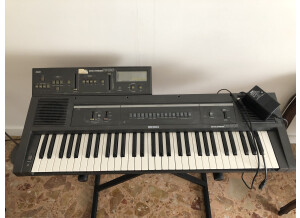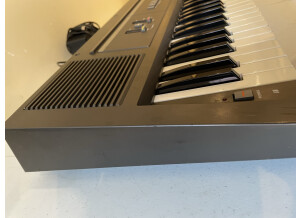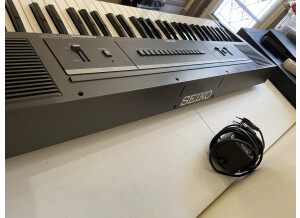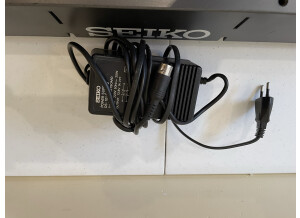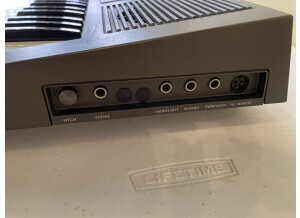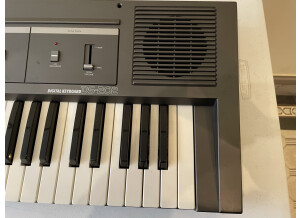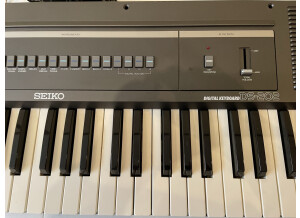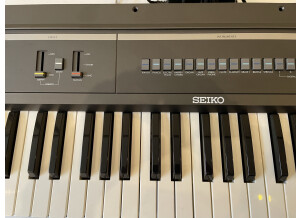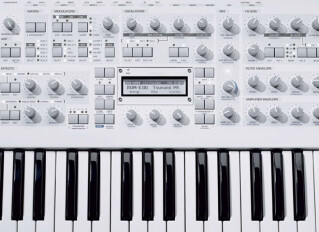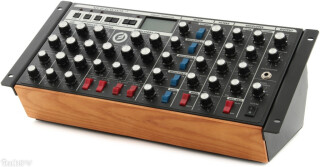Annonces DS 202/310/320.
Alerte nouvelle annonceImages
Avis
Une machine imposante des sons intéressants
Publié le 18/09/17 à 14:32Une fois le tout monté sur le synthé on est étonné de la taille de celui-ci.
Un machine robuste et bien pensée et pesant près de 7.5kg, pas de sortie midi.
Au niveau des sonorités des base il offre un son crystalin sur les sons de base
PIANO ORGAN HARPSICHORD FLUTE STRINGS ELECTRIC PIANO JAZZ ORGAN VIBRAPHONE CLARINET BRASS
Possibilité d'édition en jouant sur le filter LPF, Envelope Selector 1-4, et sauvegarde de 4 SONS, effet chorus 1 et 2
delay sans, court ou long, attack sustain, sustain release, réglable avec des sliders 'Time' précis de 0, 0.01, 0.02 , 1, 2, 3, 5 et 10...…
Une fois le tout monté sur le synthé on est étonné de la taille de celui-ci.
Un machine robuste et bien pensée et pesant près de 7.5kg, pas de sortie midi.
Au niveau des sonorités des base il offre un son crystalin sur les sons de base
PIANO ORGAN HARPSICHORD FLUTE STRINGS ELECTRIC PIANO JAZZ ORGAN VIBRAPHONE CLARINET BRASS
Possibilité d'édition en jouant sur le filter LPF, Envelope Selector 1-4, et sauvegarde de 4 SONS, effet chorus 1 et 2
delay sans, court ou long, attack sustain, sustain release, réglable avec des sliders 'Time' précis de 0, 0.01, 0.02 , 1, 2, 3, 5 et 10 seconds.
Tout est paramétrable au travers de l'écran LCD, visualization des 4 envelope porposées et réglage du spectrum possible sur 16 harmoniques.
Au niveau des effets un Chorus 1 avec slow cycle autour des 0.7 Hz, while Chorus 2 autour des 1.7 Hz., un effet Vibrato peut être ajouté. transposition du clavier,
Pas mal de possibilité de variation sur les sons donc la banque mémoire est un peu courte
Agréable au touché , prise en main rapide mais nécessite quand meme le mode d'emploi pour le sequencer et de digital synth.
Au niveau des rythmes , la boite à rythme donne un son style roland CR78. L' accompagnement basse one finger et très sympas.
Je n'ai pas encore eu l'occasion de le tester dans mon set, donc affaire à suivre....
Ce synthé est un collector vu sa rareté ,avec ses options il tournait autour des 1000 MARK à l'époque et je l'ai trouvé pour 200€ + 75€ par module et je ne regrette pas mon achat
Fiche technique
- Fabricant : Seiko
- Modèle : DS 202/310/320.
- Catégorie : Claviers synthétiseurs numériques
- Fiche créée le : 18/09/2017
| Seiko Digital Keyboards | |
| Digital Keyboards DS202 & DS101, Digital Synthesizer DS310, Digital Sequencer DS320 |
From watches to quartz metronomes and music tuners - and now, 'By introducing digital keyboards, Seiko is sure to have its presence felt'. The latter, a quote from Seiko-K. Hattori & Co. Ltd, just shows how determined this Japanese company is to capture part of the expanding 'home electronic keyboard' industry. It may seem rather late in the day, considering the innovative products from Casio that introduced the portable keyboard instrument into home leisure music, closely followed by contributions from Yamaha, Roland, JVC, Technics and others.
But Seiko has obviously examined the development of electronic keyboards and aimed at a group of products that would leap into the current state of things - particularly with digital sound synthesis, digital recording, RAM and ROM storage, and external control from a home computer.
Presentation-wise, the combination of DS202 keyboard linked to DS310 and DS320 peripherals is as hi-tech as you can get and offers a complete home music-making and recording system that's appealing to look at and plenty of fun to learn and explore its sound-making potential.
I also suspect it's likely to be popular with new bands looking for something a little different. Let's begin with the more advanced keyboard - the DS202.
DS202 Keyboard
This is an 8-voice polyphonic instrument, with 5-octave C to C keyboard and its own built-in amplification and speakers. It is therefore a self-contained music-making system (without the add-ons) providing melody, accompaniment and rhythm. Like the other keyboard and add-on modules, it's of a dark grey all-plastic construction, measuring 967 x 316.5 x 100 (WDH), and is lightweight at 7.5kg, with solid rubber feet.
The DS310 and DS320 add-ons each attach by two hooks that stop the unit coming away whilst two retaining screws are inserted. Each add-on has a ribbon cable that precludes wrong positioning left and right on the keyboard. The front plastic under the keyboard itself appeared a little too flexible for my liking, but the provision of 4 music stand holes is a good idea so you can still work on your music score or harmonic settings you've jotted down with the complete system connected up. The built-in speakers gave adequate volume for home use without noticeable distortion, although like most portable keyboards, they had the bass rolled off fairly sharply.
All the main controls are neatly arranged in logical groups above the keys, with power switch (plus LED) at keyboard left and external connections at the right end. These connections include a small Pitch Shift knob for adjusting overall pitch ±1 semitone, a stereo low impedance headphone socket, left and right phono socket outputs for an external amplifier or mixer, as well as a mixed mono output socket, and Sustain Pedal, Expression Pedal and AC Adaptor sockets. Although accessories such as Sustain and Expression pedals are optional, the wire music stand and AC Adaptor are supplied, and other 'optionals' listed are headphones, keyboard stand and a soft case.
You'll need to use the supplied adaptor to give 12 volts at 1 amp for the complete system and although the sound is fine from the built-in speakers, some hum was noticeable using headphones or external amplification, but I should stress that the review model was a prototype and hopefully the production model will be better regulated.
The main control groups are (left to right): Effect, Instruments, Auto Bass Chord, Rhythm, and Function.
Effects
The Chorus effect probably adds more to the final sound than most people realise - you'll notice the difference when comparing the DS202 with the DS101 which has no chorus. It makes a stereo image between the built-in speakers that is effective on most sound combinations. Two types of chorus can be switched in: Chorus 1 has a slow cycle at around 0.7 Hz, while Chorus 2 gives a faster movement to the sound at around 1.7 Hz. Slight extra hum and hiss could be heard on the external outputs when recording with chorus added to this prototype instrument.
Vibrato can be added by means of a Depth slider at a fixed 'medium' rate of 0.2Hz for all instrument sounds and a Delay of 1 second can be switched in if desired.
Sustain is provided on a 'switching' slider for short (0.6 secs) and long (2.6 secs) fixed times. Incidentally, all the sliders have been orientated to give off/min settings at the top, rather than at the bottom! DS202 control panel directly above keyboard.
Instruments
With only ten preset sounds to choose from I'll examine these and the other soundmaking features fairly closely. In this section there are two rows of micro buttons that will call up one factory-preset sound at a time, although the next section on the panel offers split keyboard and mixed instrument sounds as well - all retaining 8-note polyphony too! That is a very good feature indeed.
Generally, the instrument sounds are evenly balanced in volume over the keyboard range, with only very slight DC thump present. Here's my comments on the instruments one by one:
PIANO A fairly good representation that's best at octaves 2, 3 and 4 on chordal stuff, but the lowest octave is too resonant. The LF thump is realistic on this sound and it's improved by adding Chorus 1 for depth or Chorus 2 plus Vibrato for honky-tonk detuning. The Sustain pedal is obviously useful too.
ORGAN Church full organ with mixtures type of sound, with less harmonics evident on high notes due to filtering. Chorus 1 gives a nice 'Chorale' effect.
HARPSICHORD Rather too flutey and not spikey enough, especially in the lowest octave.
FLUTE Has a soft attack and is better with delayed Vibrato. The waveform interestingly changes at mid-keyboard from rounded square to triangle. With Chorus 2 a pleasant flute ensemble is created, although you'll not hear any breath or chiff.
STRINGS A solo sound that's more viola than violin in timbre. Adding Chorus 2 with delayed Vibrato gives a string ensemble. The sound is a little woolly, maybe too organ-like, with slow attack but short sustain/release, and really needs extra phasing to be orchestral. There is an answer to this which I'll mention later.
ELECTRIC PIANO This mellow version of the Piano sound is really the flute sound with short attack. It's fine to use except at the lowest octave where chords naturally become rather muddy and softer.
JAZZ ORGAN Has a nice harmonic chiff on its attack. The top octave loses on harmonics with really rich sounds in the lower range. Chorus improves the sound even more and makes up for the lack of percussion.
VIBRAPHONE The 'beater' is done by high harmonics, although it could be more realistic. Sounds best with Chorus 2 and full vibrato.
CLARINET Not a clarinet! - More a harmonium or squeezebox. Adding delayed vibrato helps.
BRASS A little flute-like, but much better than a lot of electronic keyboard presets. It has the resonant puff of an euphonium plus straight trumpet pulsewave. Big ensemble sound with Chorus 2 and with less filtering it would have been very good. Create this on the DS310 without its low pass filter on and mix it with the Brass preset and you've got it!
The DS202 has four modes of operation: Normal, Simple Finger Chord, Keysplit and Sound-Mix.
Normal gives one preset sound over the whole keyboard plus use of Rhythm, Effect and Function sections.
In Single Finger Chord mode you can select any one of the ten instruments to be the chord accompaniment - this is low pass filtered to keep the melody dominant. The bass line created for the accompaniment has a nice thump to its attack for a percussive feel. What makes this a very usable auto feature is that chords will change on every beat if necessary. Even though it is called single fingered chord, making major and minor sevenths with only two fingers, I found that I could set most other chords by correct playing. The only anomaly was the Minor 6th which switched the root to the sixth. The Auto Bass Chord notes available on the lower half of the keyboard in fact go one further than marked! The Chorus effect works on the accompaniment but Sustain and Vibrato are sensibly excluded.
The placing of chords to fit the rhythm selected is quite straightforward: Waltz 1&2, Latin 1&2, 2 Beat, Swing use either straight offbeat chords or syncopation in normal and variation modes. 8 Beat is either offbeat or quavers, and 16 Beat variation is more syncopated.
Most Bass lines revolve round root and fifth with occasional octave or third addition. Swing has the most ambitious bass line: 1, 3, 5, 6, Oct, 6, 5, 3.
The accompaniment is therefore fairly basic but since you can choose your sound it still has plenty of scope. One big drawback is the lack of independent Bass line volume control and can only be overcome by selecting a suitable chord preset to balance with it.
In Keysplit mode, the keyboard can be allocated a different preset in lower and upper halves, with split point fixed at centre E, F notes. A useful feature is the option to put the lower half up an octave and the upper half down one octave to bring both sides to 'equal' pitch. The 'Tone Set' button allocates the lower keyboard preset sound and is simply followed by a choice of preset for the upper half. Balancing of both parts of the keyboard is done by means of the Auto Bass Chord Volume/Balance slider.
The fourth mode of operation is called Sound Mix and allows two preset sounds to be played together. Selection and balancing of sounds is as in Keysplit mode. It is also possible to add the same sound again, resulting in a much richer effect. If you're recording just with the preset sounds then this is an ideal mode to use, immediately widening the instrument's sound potential - especially as it includes mixing of the DS310 sounds.
Rhythm Section
Here you can select one of eight rhythms that are all quite basic, using a maximum of 4 percussive sounds at any time. These are called 8 Beat, Slow Rock, 16 Beat, 2 Beat, Waltz, Swing, Latin 1 and Latin 2. The Variation button in the Accompaniment section does not change the rhythm selected as happens on quite a few other keyboards.
On the review instrument, the Bass Drum low frequency was too ringing at high output and a little long. Snare was fine and the Hi-Hat was simply white noise stuff. Some rhythms also employed a metallic cymbal - a ring modulated type with slight white noise added - that was too short to be natural.
Each rhythm occupies one bar only, with B. Drum varied between ¼ and dotted ¼ plus 1/8 beats, while snare most of the time had off-beats. The biggest change from one rhythm to the next came from the Hi-Hat, from 1/8 beats, dotted 8's plus 16's, and triplet 8's. Swing is particularly poor because the 'crash' cymbal is trying to do the dotted swing beat.
Rhythm adjustment is made with Tempo and Volume sliders, and 'immediate' or 'start with keyed accompaniment' switches.
In the final control section marked 'Function' is a Transpose switch and output volume slider.
Transposition of the keyboard notes you play is set using the lowest octave notes, C to C. The bottom C note will transpose the entire keyboard in Normal Mode down 1 octave - this does not also put the accompaniment down for obvious reasons. The other notes transpose upwards to the chosen key, up to an octave. Electric piano and Flute presets were not suited to '1 octave down' transposition as they became too quiet.
The Volume slider affects all outputs: the built-in speakers, headphones, and stereo/mono out. This is particularly awkward when using the latter outputs for recording with headphones later at night (don't all the best composers work at night?!) as there's no way of cutting out the speakers, short of fitting a simple switch and load resistors. I'm not very keen on the headphone link cutting out the line output completely.
One point about the Tuning control on the side of the instrument. In this location it makes it difficult to get some sort of poly or mono portamento/glide (limited to 2 tone range). On the other hand, it's not likely to get knocked accidentally and it wasn't really designed for that purpose!
The Digital Synthesizer DS310 is mounted onto the left hand side of the DS202 keyboard and as well as being the first low cost add-on of its kind, it offers some great sounds - with the Low Pass Filter switched out, they are crystal clear and very exciting to play - and no doubt the compact size is due to Seiko's experience in LSI technology.
Four of your own created sounds can be stored in the DS310 by means of 'Tone Memory' buttons 1-4. Soundmaking is an easy step by step process with, most importantly, instant aural verification from the keyboard. Two modes of setting up a sound are required, first with choice of a suitable 'Spectrum' and second, by selecting an 'Envelope'. A special LCD display gives very clear indication of your Spectrum and Envelope settings.
This part of setting up refers to the selection of up to 16 'harmonics' - actually harmonic number 1 is the fundamental, followed by 15 more in the harmonic series.
Each harmonic is a sine wave at a fixed pitch in relation to the fundamental, thus brighter sounds employ greater amounts of higher numbered harmonics. The process is called additive synthesis and any combination of harmonics can be selected by pressing the 'Set' switch to move through harmonics 1 to 16 step by step whilst adjusting their individual intensity with the special 16-position switch/slider.
The LCD display shows the intensity of each harmonic in bar graph form and the current sound will be heard on depression of a key. The process of selecting harmonics is done 3 times - for Attack, Sustain and Release parts of the Envelope selected in the second stage of soundmaking. In this way you'll hear changing tones during the opening and closing of a sound envelope just as the VCF alters on an analogue synth, but far more precisely detailed.
At any time during use of the DS310 you can switch in or out an additional Low Pass Filter that reduces top brightness noticeably for creating mellow sounds. Most of the time you'll not want it on to retain the clarity possible with this section.
The second step in making your sound is to find a suitable basic envelope shape to operate the harmonic structures created for attack, sustain and release. Four 'Envelope Selector' buttons enable contrasting shapes to be used. What is different from analogue envelopes is that, as the LCD displays of these show, they each have rise and fall segments for all 3 parts of the envelope.
It's quite hard to define the different envelopes in words, but Env. I & II are basically the same, with Env. I best for stronger sustain and Env. II used for a stronger attack. Both of these are sustain 'hold' types. Env. III emphasises attack and sustain peaks, while Env. IV has diminishing segments. These two give a full envelope on key play for percussive sounds.
The next step is to choose times for attack to sustain, sustain to release, and release using a special switch slider for 'Time'. Precise time values can be entered from 0, 0.01, 0.02 through to 1, 2, 3, 5 and 10 seconds. The chosen values are displayed on the LCD underneath the Envelope selected.
Some of the points to note in using this section are that the 'Intensity' setting of harmonics appears to give the same volume out and listening on headphones, the fundamental was breaking through slightly. However, in fairness, I should point out that the review instruments had been well and truly shown across the world and had just arrived from Chicago, so inevitably internal presets may have become mis-set during the tour.
To select a sound from this unit, as opposed to one of the presets on the DS202 keyboard, you simply press one of the following buttons: Tone Memory 1-4, Envelope Selector 1-4, or the LPF button.
The attack is very sharp and clean at minimum (zero) setting and allows very bright harmonics to be used to initiate sounds. A 'Step' switch is provided to progressively cycle back through Spectrum or Envelope settings. The keyboard's Sustain, Vibrato and Chorus controls all operate with the DS310's sounds. Although soundmaking is done with the keyboard in Normal mode, you can 'Tone Set' all your own sounds from the DS310 in Chord, Keysplit and Sound Mix modes as well, and this is quite unique in that your accompaniment can be using your own sound.
DS320
The Digital Sequencer DS320 is mounted above the right-hand side of the keyboard and will memorise a total of 4 sequences using up to 4 melody lines and 1 chord sequence for automatic polyphonic playback. A digital memory cassette (RAM for your own sequences and ROM for 16 prepared selections that you can purchase) is an important feature of this unit and its addition puts the whole system into a class of its own. Playing along with recorded sequences is possible and a Liquid Crystal Display contains information for full editing of track sequence easily.
The DS320 has 3 modes of operation: 'Manual input' for recording each melodic line one note (or chord) at a time, 'Real Time Input' for recording notes as they are played on the keyboard, and 'Play' which plays back your selected combination of lines 1-4, and chords.
I like the way the 'Line' LEDs come on to show the line is in use or already recorded, and monitoring is easily done by calling up lines. But it's unfortunate that you can't locate a bar without having to run right through from the start - the 'Start/Stop' button always resets the sequence to the beginning. You can't even play to the edit point, stop, and switch to manual or real time without it resetting to start again. Measures count differently on the LCD if you've been inserting repeats, DS, DC, etc, but in Manual Input the editing of measures is exactly as from your prepared score. A repeat always takes the longest line and then repeats and the sequencer tidies up endings well for this.
If you change preset sounds during playback, there's a slight silence before the changeover which can be annoying and almost precludes using several instruments one after another in sequence. I wonder why the sequencer was not able to store rhythm and instrument preset selection as well, or perhaps I'm asking too much. Perhaps that is where the computer interface (non-MIDI type) is to come in, but I shall be surprised to see music printing, sound libraries, multiple keyboard link-up as suggested in the brochures become available for home computers in the next year.
No external clock input for the sequencer is provided and no information was available on the computer socket, so it's possible that it may be pulse driven here. Otherwise, sync'ing to other instruments or multitrackers can't be done. One thing I had to watch with the sequencer was that if you record on a line that's already been used to record with, you might leave some that will be heard after the new sequence as it is simply added on - pressing the 'Stop' button correctly helps. And if you start from the very first beat in Real Time Input, you're sure to lose this note on playback.
There's nothing quite like this system around so it deserved this close look at its operation. The add-ons, for me, make the Seiko system a lot of pleasure to use and as I've pointed out, the Digital Synthesizer greatly increases the creative use of the instrument, whilst the Sequencer will become an invaluable tool for anyone wanting to experiment with composing complete pieces. Hopefully, the instruments will come with a well-written instruction manual as the digital synthesis and recording process in particular need clear explanation. The price of the keyboards does seem to be marginally higher than most, with the DS202 at £545, and the DS101 at £399. You'll have to pay a further £269 for the DS310 and £299 for the DS320. The complete DS202 package will probably retail around the £1000 mark.
The DS101 keyboard is not in the same league as the DS202: it's mono, not stereo, utilizes the same plastic case with different centre control panel (and circuitry!), has clicks between the 16 preset changes if notes are being held, and its digital sounds built-in are not very usable except for effects.
Coming back to the DS202-based system, I'm sure a good many musicians will want this to be their No.1 Christmas present this year. And as the photographs show, Seiko seem to be well on the way to providing software/hardware interfacing for home computers which could open up the use of both keyboards tremendously. I have a feeling that the whole thing would be better off with a cartridge for the DS310 like the DS320, but for sound storage, so that it really does become a complete system in itself.
Autres catégories dans Synthétiseurs
Autres dénominations : ds 202 310 320, ds202310320, ds202 310 320, ds20 2310 320




